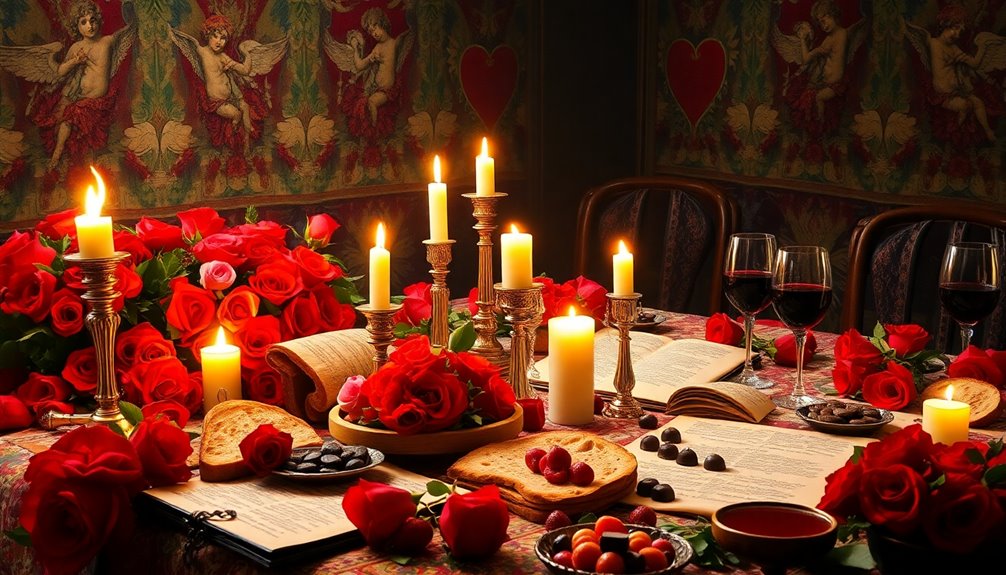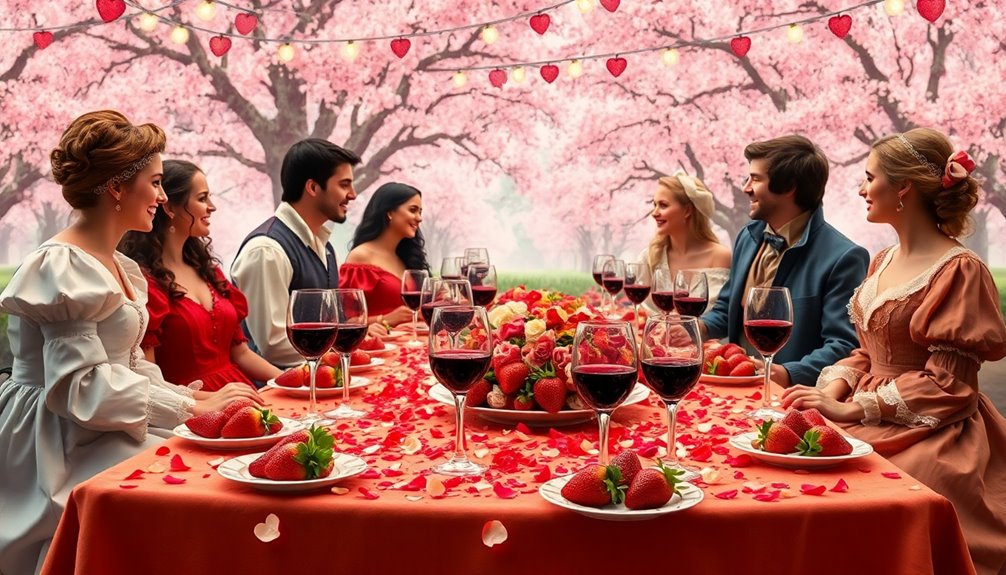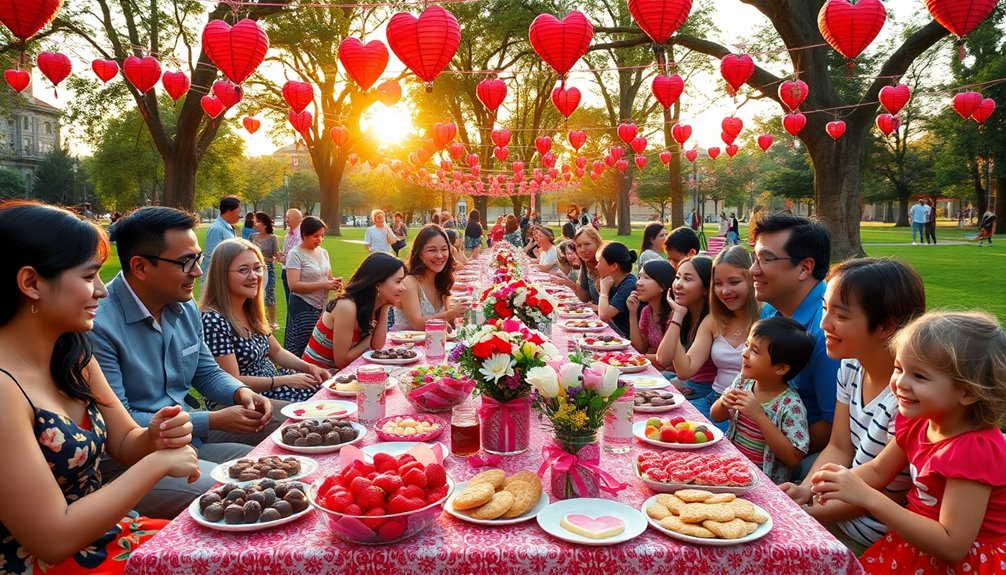Valentine's Day has deep roots in ancient Rome's Lupercalia festival, focusing on fertility and love. The legend of Saint Valentine, who defied a marriage ban, adds a romantic touch to the holiday. Over centuries, it evolved from love notes in the 15th century to mass-produced cards by the 19th century. Today, Cupid symbolizes affection, while global customs enrich the celebration. There are fascinating traditions around the world that you'll want to discover.
Key Takeaways
- Valentine's Day originated from ancient Rome's Lupercalia festival, celebrating fertility and romantic pairings through playful rituals.
- The feast day of Saint Valentine, associated with love, was established by Pope Gelasius I in the late 5th century.
- Saint Valentine secretly married couples despite Emperor Claudius II's marriage ban, leading to his martyrdom and recognition by the Catholic Church.
- Geoffrey Chaucer's 14th-century poem linked February 14 to romantic love, influencing future traditions of exchanging love notes.
- Global celebrations include unique customs, such as mass weddings in the Philippines and "giri-choco" gifting in Japan.
The Ancient Roots of Valentine's Day

While many people celebrate Valentine's Day with flowers and chocolates today, its origins trace back to ancient Rome's Lupercalia festival.
Held in mid-February, Lupercalia focused on fertility and pairing off partners through playful rituals. Dedicated to Faunus, the Roman god of agriculture, this festival blurred the lines between revelry and romantic love.
In the late 5th century, Pope Gelasius I sought to replace these pagan traditions, declaring February 14 as the feast day of Saint Valentine.
Saint Valentine, a priest, defied Emperor Claudius II's marriage ban, secretly performing weddings for young couples, which ultimately led to his martyrdom.
The Legend of Saint Valentine

You might be surprised to learn that the legend of Saint Valentine is filled with tales of love and sacrifice.
From his defiance against Emperor Claudius II's marriage ban to the heartfelt note he sent from prison, these stories highlight his enduring legacy.
As you explore these martyrdom accounts, you'll see why he became a symbol of love through the ages.
Saint Valentine's Martyrdom Stories
Although many legends surround him, the story of Saint Valentine remains a powerful tribute to love and sacrifice. He defied Emperor Claudius II's ban on marriages, ultimately leading to his martyrdom around A.D. 269. Imprisoned, he performed a miraculous healing for his jailer's blind daughter, Asterius. Before his execution, he sent a farewell note to her, signing it "Your Valentine," which sparked the romantic tradition we cherish today. The Catholic Church recognized him as a martyr, and his feast day is celebrated on February 14, forever linking his name to love.
| Aspect | Details |
|---|---|
| Name | Saint Valentine |
| Emperor | Claudius II |
| Notable Act | Healing and farewell note |
| Feast Day | February 14 |
Legends of Love Letters
As the legend goes, Saint Valentine's secret love letters became a symbol of defiance against oppression, forever changing how we express affection.
This brave priest performed secret marriages for young couples, challenging Emperor Claudius II's marriage ban, which ultimately led to his arrest and execution.
Before he was executed, he restored sight to his jailer's blind daughter, Asterius, and sent her a touching farewell note signed "Your Valentine."
This heartfelt gesture birthed the iconic phrase, linking it to romantic love.
February 14 now commemorates these legends, and Geoffrey Chaucer popularized the day in the 14th century, intertwining it with themes of courtly love.
Today, these stories continue to inspire the way we share love letters.
Romantic Associations Through the Ages

Since its inception, Valentine's Day has evolved into a celebration steeped in romantic associations, shaping how you express affection.
Beginning with Geoffrey Chaucer's 14th-century poem, which suggested that birds choose their mates on February 14, the day gradually became synonymous with romantic love.
- In the 15th century, you might've sent love notes as tokens of affection.
- By the 19th century, greeting cards became mass-produced, changing how you share your feelings.
- The Victorian era popularized symbols of love, like hearts and doves, cementing Valentine's Day traditions.
Today, with the commercialization of the holiday, you likely spend an average of $192.80 on gifts and celebrations, reflecting the deep-rooted romantic connections associated with this special day. This celebration not only honors romantic love but also emphasizes the importance of unconditional love that forms the foundation of lasting relationships.
Cupid: The Symbol of Love

Valentine's Day wouldn't be the same without Cupid, the iconic symbol of love that captures the spirit of the holiday.
Originally known as Eros, the god of love in Greek mythology, Cupid's image evolved during the Hellenistic period into the chubby cherub we recognize today.
Associated with Venus, the goddess of love, Cupid's arrows ignite romantic affection and desire in hearts worldwide.
You'll find him gracing greeting cards and gifts, reminding lovers of their deep connections.
In modern culture, Cupid plays an essential role in Valentine's Day marketing, contributing to the staggering $18.2 billion spent on the holiday in 2017.
His playful presence continues to inspire love and passion, making each celebration unforgettable. Additionally, merchants can capitalize on payment processing options to enhance their Valentine's Day sales strategies.
Evolution of Valentine's Day Customs

The evolution of Valentine's Day customs reveals a fascinating journey from ancient rituals to modern expressions of love. Originating from the Roman celebration of Lupercalia, it changed into a feast day of St. Valentine, highlighting themes of love and affection.
- Geoffrey Chaucer's poetry in the 14th century linked the day to romantic love, inspiring the early tradition of exchanging small tokens.
- By the 18th century, handwritten notes blossomed into Valentines Day cards, paving the way for Esther Howland's mass-produced options.
- The late 19th century introduced a commercial celebration of romance, with heart-shaped chocolate boxes marking a significant shift.
Today, modern Valentines encompass a variety of gifts, reflecting evolving attitudes toward love and connection.
Global Celebrations and Unique Traditions

As different cultures around the world celebrate love, unique traditions emerge that reflect local customs and values.
In Latin America, Valentine's Day transforms into "Día de los Enamorados," where friends exchange cards and flowers.
Japan has a unique custom known as "giri-choco," where women give chocolates to men, with men reciprocating on White Day.
South Korea offers a cultural twist with Black Day, where singles gather to eat black noodles, lamenting their status.
In the Philippines, couples enjoy mass weddings, celebrating love in large public ceremonies.
Meanwhile, in Slovenia, February 14 symbolizes spring's arrival, marking the day when birds mate, intertwining romance with nature.
Each celebration highlights love's diverse expressions across the globe. Additionally, these traditions often involve local customs and values, showcasing how cultural significance influences celebrations.
Frequently Asked Questions
What Historical Events Happened on Valentine's Day?
On Valentine's Day, several significant historical events occurred.
In 269, Saint Valentine was executed for defying a marriage ban, marking a pivotal moment.
Fast forward to 496, when Pope Gelasius I declared February 14 the Feast of Saint Valentine, solidifying its religious significance.
Then in 1375, Geoffrey Chaucer wrote a poem linking the day to romantic love.
Finally, in 1913, Hallmark produced its first mass-produced Valentine's Day cards, changing how you express love.
What Is the History of Valentine's Day Celebration?
Imagine a time when courtly love reigned supreme, echoing through Geoffrey Chaucer's verses.
You're diving into the history of Valentine's Day, which started as a feast honoring Saint Valentine in AD 496. Over the centuries, it transformed from a solemn occasion to a celebration of love.
What Is the Traditional Celebration of Valentine's Day?
On Valentine's Day, you typically celebrate love and affection with your partner.
You might exchange heartfelt cards, flowers, and chocolates, showing how much you care.
Romantic dinners are common, often featuring candlelight and special menus.
Some choose to give jewelry or plan unique experiences to make the day memorable.
Whatever you decide, the essence of the celebration lies in expressing your feelings and deepening your connection with that special someone in your life.
Is Valentine's Day a Feast Day?
You might think of Valentine's Day as a time for chocolates and roses, but it's also recognized as a feast day in certain traditions.
On February 14th, it honors Saint Valentine, a figure associated with love and sacrifice.
While it's not a public holiday, in some Christian denominations, it's celebrated with religious significance.
Conclusion
In exploring the rich history of Valentine's Day, you uncover a tapestry woven with ancient traditions and evolving customs. Did you know that nearly 1 in 5 people in the U.S. celebrate this day by sending flowers, making it one of the most popular gift choices? As you embrace the spirit of love and connection, remember that each celebration, whether grand or simple, carries a legacy that dates back centuries, reminding us of love's timeless power.









